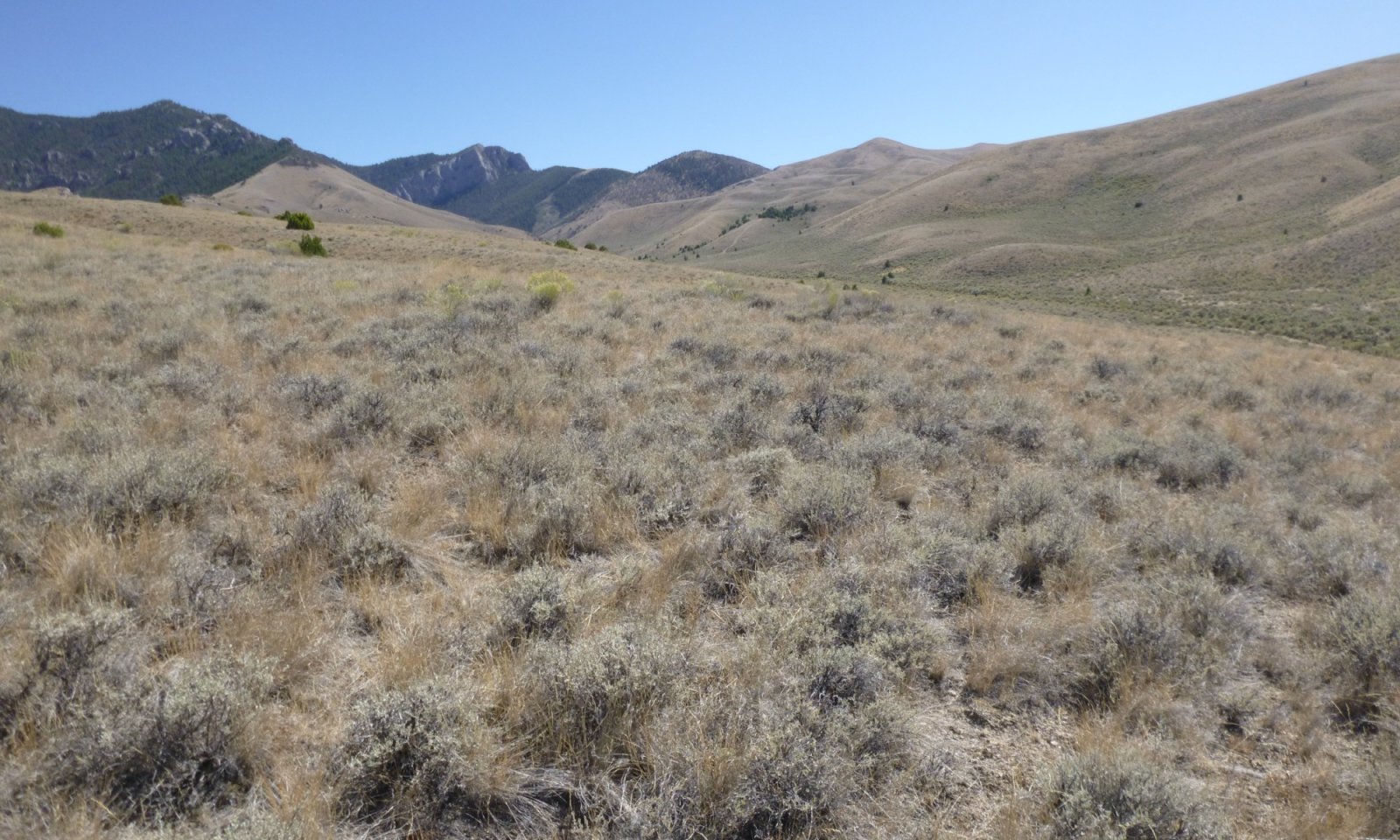

Natural Resources
Conservation Service
Ecological site BX012X02B063
Shallow to Loamy, Calcareous 10-14 Inch Precipitation Zone Lost River Mountains
Last updated: 5/07/2025
Accessed: 05/19/2025
General information
Provisional. A provisional ecological site description has undergone quality control and quality assurance review. It contains a working state and transition model and enough information to identify the ecological site.
MLRA notes
Major Land Resource Area (MLRA): 012X–Lost River Valleys and Mountains
Major Land Resource Area (MLRA) 012X, Lost River Valleys and Mountains, consists of approximately 4.85 million acres in Idaho. MLRA 012X is broken into two Land Resource Units (LRU) based on geology, landscape, common soils, water resources, and plant community potentials. The elevation ranges from approximately 3,600 feet (1,100 meters) in the valleys and extends to the highest point in Idaho, Mt. Borah, at 12,662 feet (3,869 meters). Annual precipitation has a significant range from six to 47 inches, the driest areas in the valley bottoms and the wettest areas on the mountain summits. This MLRA encompasses portions of the Salmon-Challis National Forest, small amounts of private land, as well as other public land managed by the State of Idaho and the Bureau of Land Management. The Continental Divide runs through the Beaverhead Mountain Range directly east of the MLRA and adjacent forests and parks include the Beaverhead National Forest, Custer Gallatin National Forest, Caribou-Targhee National Forest, and Craters of the Moon National Park.
LRU notes
The Lost River Mountain LRU is located on the Lemhi, Lost River, and White Knob Mountain Ranges. These mountain ranges extend from Salmon, Idaho to the north, Craters of the Moon National Monument to the south, the Beaverhead Mountain Range to the east, and the Sawtooth Mountains to the west. This LRU borders MLRA 043B - Central Rocky Mountains, and a small portion of MLRA 010X - Central Rocky Mountains and Foothills.
The geology of this LRU is comprised mostly of colluvium from the Challis Volcanic Group, limestone from the Permian to Mississippian Period, and till from Pleistocene glacial deposits. Additionally, metasedimentary formations from the Proterozoic dominate the Lemhi Range. The elevation range of this LRU is similar to that of the MLRA (approximately 4,000 to 12,500 feet). The boundary of the unit begins where the three mountain ranges meet the valley floor and extends to the mountain peaks. Effective precipitation (estimate of the moisture available for plant use and soil forming processes at a given site) generally ranges between 10 to greater than 36 inches. The soil temperature regimes present are frigid and cryic, and the soil moisture regimes include xeric and udic. The soils for the LRU are dominated by mollisols and inceptisols from limestone and quartzite parent material, as well as glacial till.
Classification relationships
Relationship to Other Established Classification Systems
National Vegetation Classification System (NVC):
3 Semi-Desert
3.B.1 Cool Semi-Desert Scrub & Grassland
3.B.1.Ne Western North American Cool Semi-Desert Scrub & Grassland Division
M170 Great Basin-Intermountain Dry Shrubland & Grassland Macrogroup
G308 Intermountain Low & Black Sagebrush Steppe & Shrubland Group
A3222 Black Sagebrush Steppe & Shrubland Alliance
CEGL001424 Black Sagebrush/Bluebunch Wheatgrass Shrubland Association
Ecoregions (EPA):
Level I: 10 Northwestern Forested Mountains
Level II: 10.1 Western Cordillera
Level III: 10.1.4 Middle Rockies
Ecological site concept
The Shallow to Loamy Calcareous 10 -14 Inch Precipitation Zone (SwLyC 10-14") is an upland ecological site with loamy surface textures, limited by soil chemistry in the four to 10 inch (10 to 25 centimeter) section of the soil profile. The site is moderately deep to very deep to restrictions, but shallow to highly calcareous soils. This site does not receive additional water.
These soils:
o Are not saline, saline-sodic, or sodic
o Are moderately deep, deep, or very deep
o Are highly calcareous having greater than 15 percent calcium carbonate equivalency (CCE) within the top 10 to 25 centimeters (four to 10 inches) of the soil profile.
The primary limiting factors shaping plant communities for this ecological site involve soil chemistry and moderate relative effective annual precipitation in relation to the LRU. Having highly calcareous soils (greater than 15 percent CCE) within the top 10 to 25 centimeters of the soil profile creates conditions suitable to a specific group of species, specifically in the low sagebrush communities (little and black sagebrush - Artemisia arbuscula and Artemisia nova). Moderate relative effective annual precipitation at this site may lessen the resource restrictions created by calcareous soils and allow for mountain big sagebrush to establish in communities at the higher end of the precipitation range.
Associated sites
| BX012X02B020 |
Limy 10 to 14 Inch Precipitation Zone Lost River Mountains This site is also usually found on limestone parent material. |
|---|---|
| BX012X02B026 |
Loamy Calcareous 10-14 Inch Precipitation Zone Lost River Mountains This site is also found on limestone parent material. |
| BX012X02B034 |
Rocky Hills 10-14 Inch Precipitation Zone Lost River Mountains This site can be found on rock outcroppings and ridges where soil is shallow to bedrock. |
| BX012X02B072 |
Steep Skeletal 10-14 Inch Precipitation Zone Lost River Mountains This site can be found adjacent on slopes greater than 30 percent. |
Similar sites
| BX012X02B026 |
Loamy Calcareous 10-14 Inch Precipitation Zone Lost River Mountains This site has similar textures and volume of course fragments within the top 50cm, however, calcium carbonate equivalency does not exceed 15% until the 25-50cm section of the soil profile. |
|---|---|
| BX012X02B034 |
Rocky Hills 10-14 Inch Precipitation Zone Lost River Mountains This site often has highly calcareous soils, but it is characterized by outcrops of bedrock close to the surface and the presence of curl leaf mountain mahogany. |
| BX012X02B020 |
Limy 10 to 14 Inch Precipitation Zone Lost River Mountains This site has highly calcareous soils in the 0-10cm portion of the soil profile. |
Table 1. Dominant plant species
| Tree |
Not specified |
|---|---|
| Shrub |
Not specified |
| Herbaceous |
Not specified |
Legacy ID
R012XB063ID
Physiographic features
This occurs on mountain slope, alluvial fan, or eroded fan remnants within the mountain landscape. The site is not aspect-dependent, however, aspect may influence the elevation at which it occurs. Additionally, this site is not influenced by slope percentage but generally occurs on slopes ranging from 16 to 40 percent. Runoff is generally low to moderate and flooding and ponding do not occur.
Landscape Definition:
Mountains -- A region or landscape characterized by mountains and their intervening valleys.
Landform Definition:
Mountain Slope -- A part of a mountain between the summit and the foot.
Alluvial fan -- A low, outspread mass of loose materials and/or rock material, commonly with gentle slopes, shaped like an open fan or a segment of a cone, deposited by a stream (best expressed in semiarid regions) at the place where it issues from a narrow mountain or upland valley.
Eroded fan remnant -- All, or a portion of an
alluvial fan that is much more extensively eroded
and dissected than a fan remnant.
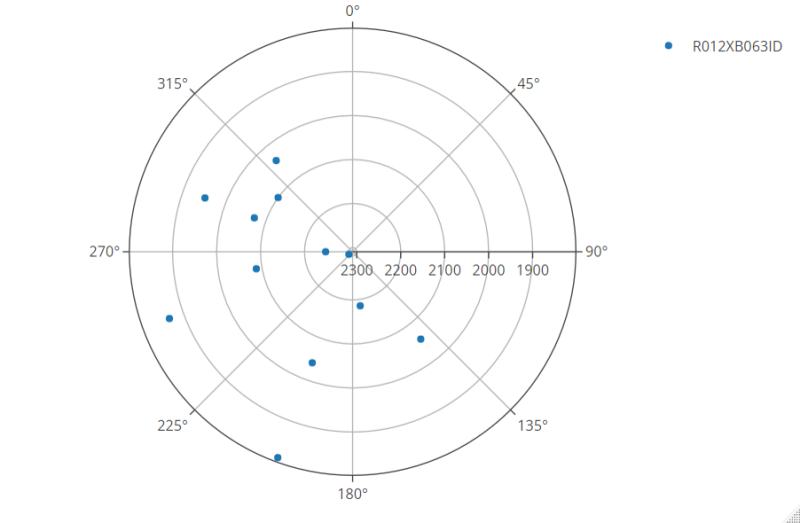
Figure 1. Plot showing aspect and elevation of 12 Shallow to Loamy Calcareous 10 to 14 inch ecological sites.
Table 2. Representative physiographic features
| Landforms |
(1)
Mountains
> Alluvial fan
(2) Mountains > Mountain slope (3) Mountains > Eroded fan remnant |
|---|---|
| Flooding frequency | None |
| Ponding frequency | None |
| Elevation | 6,459 – 7,112 ft |
| Slope | 16 – 40% |
| Aspect | W, NW, SE, S, SW |
Table 3. Representative physiographic features (actual ranges)
| Flooding frequency | Not specified |
|---|---|
| Ponding frequency | Not specified |
| Elevation | 6,040 – 7,449 ft |
| Slope | 7 – 46% |
Climatic features
In the Lost River Mountain LRU, both precipitation and temperatures fluctuate significantly throughout the seasons and year to year. Relative effective annual precipitation (estimate of the moisture available for plant use and soil forming processes at a given site) generally ranges between 10 to greater than 36 inches. Average daily temperatures during the growing season (April to August) range from 33 to 57 degrees Fahrenheit. These wide fluctuations in temperature and precipitation are largely due to elevation and aspect differences as well as lower relative humidities and drier air in the mountainous terrain of the LRU. The wettest months in terms of rainfall are May and June. The growing season varies across the LRU in relation to topographical and local conditions; however, generally ranges between 30 to 90 days. Most primary growth occurs from late April through June. Soil temperature regimes include cryic and frigid and soil moisture regimes include xeric and udic.
For this ecological site, the effective precipitation is 10 to 14 inches. Effective precipitation is a modeled value that considers annual precipitation, aspect, elevation, slope, and slope shape. Often this value will be greater than or less than annual precipitation values in relation to these other characteristics. Below 10 inches and above 14 inches, a notable shift will occur in dominant plant community composition, canopy cover, and production value.
Table 4. Representative climatic features
| Frost-free period (characteristic range) | 38-51 days |
|---|---|
| Freeze-free period (characteristic range) | 86-106 days |
| Precipitation total (characteristic range) | 8-9 in |
| Frost-free period (actual range) | 34-55 days |
| Freeze-free period (actual range) | 82-110 days |
| Precipitation total (actual range) | 8-10 in |
| Frost-free period (average) | 45 days |
| Freeze-free period (average) | 96 days |
| Precipitation total (average) | 9 in |
Figure 2. Monthly precipitation range
Figure 3. Monthly minimum temperature range
Figure 4. Monthly maximum temperature range
Figure 5. Monthly average minimum and maximum temperature
Figure 6. Annual precipitation pattern
Figure 7. Annual average temperature pattern
Climate stations used
-
(1) CHILLY BARTON FLAT [USC00101671], Mackay, ID
-
(2) MACKAY LOST RIVER RS [USC00105462], Mackay, ID
Influencing water features
This is an upland ecological site and is not influenced by additional water beyond the precipitation the site receives.
Wetland description
This ecological site is not associated with wetlands.
Soil features
The soils of this ecological site are moderately deep to very deep, ranging from 20 to greater than 80 inches (50 to 200 centimeters) and consist of textures ranging from fine sandy loams to clay loams. Soils can be skeletal (greater than 35 percent coarse fragments) and are primarily formed from slope alluvium and colluvium derived from limestone. Soils are highly calcareous within four to 10 inches (15 to 25 centimeters) of the soil surface. This is represented by a calcium carbonate equivalency (CCE) greater than 15 percent which is identified by having a pH of 7.8 or greater coupled with an effervescence of strong or higher. These soils are well-drained.
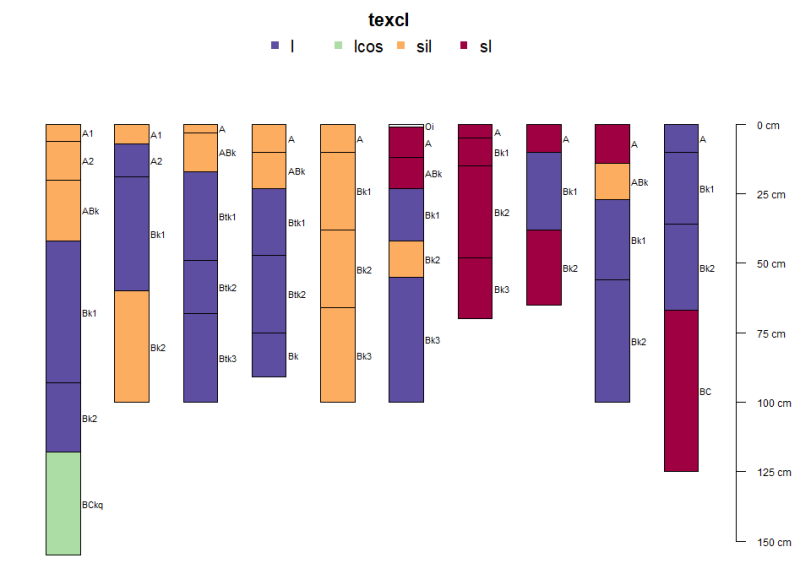
Figure 8. Plot of Shallow to Loamy Calcareous sites by horizon texture.
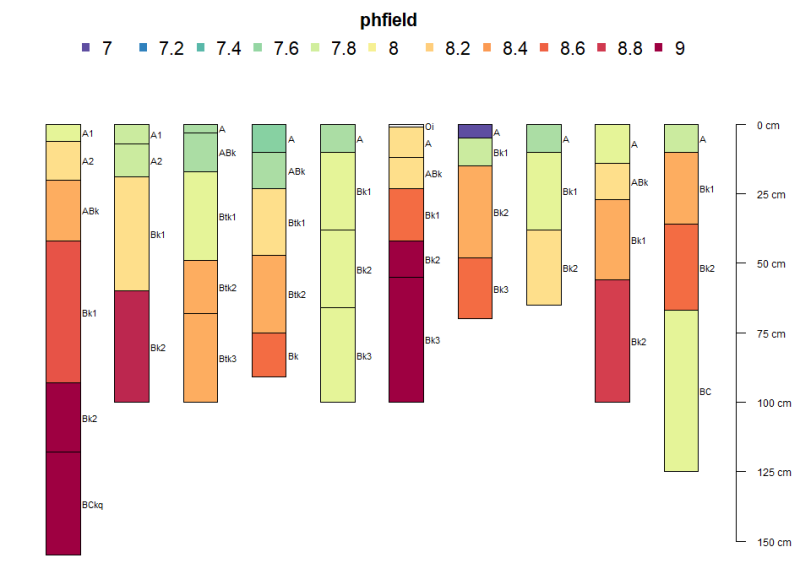
Figure 9. Plot of Shallow to Loamy Calcareous sites by horizon pH.
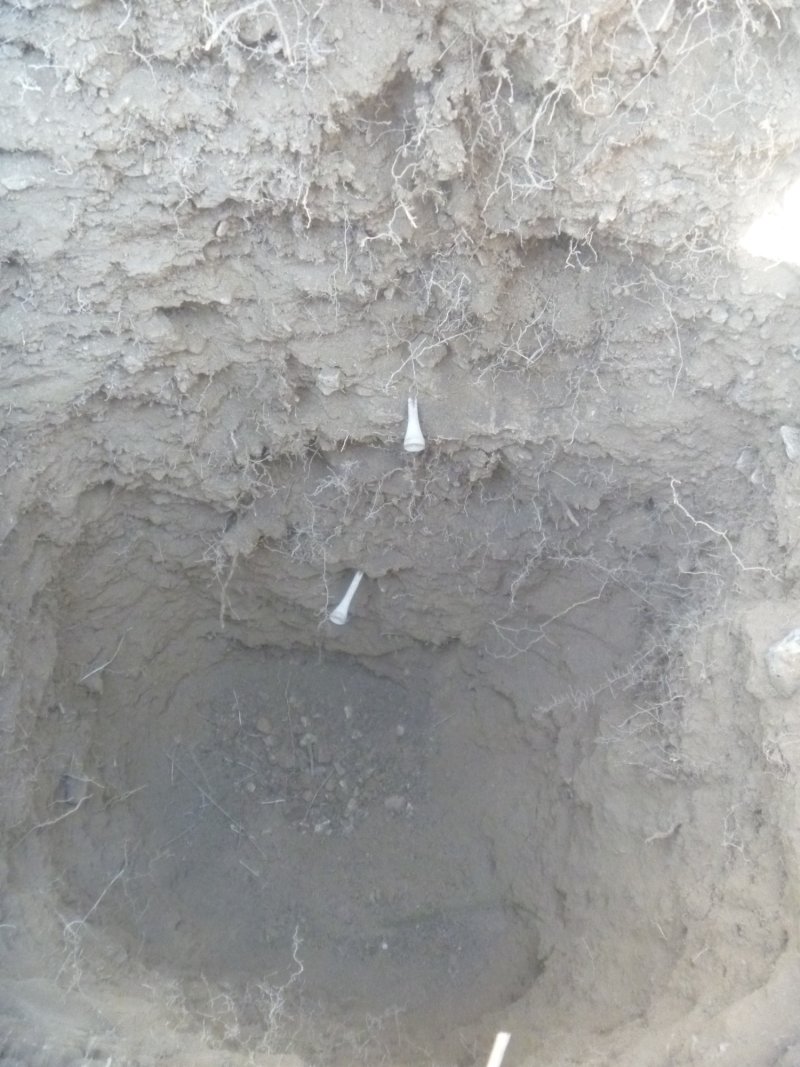
Figure 10.
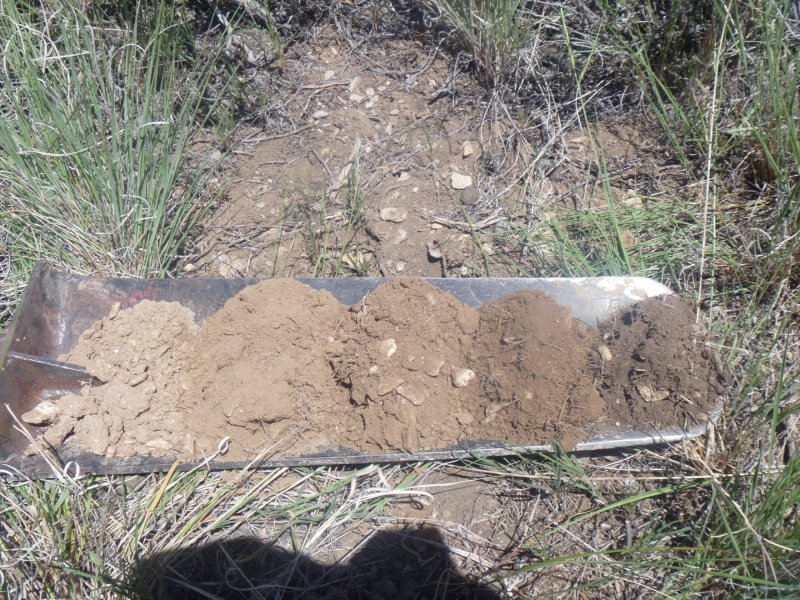
Figure 11.
Table 5. Representative soil features
| Parent material |
(1)
Alluvium
–
limestone
(2) Slope alluvium – limestone (3) Colluvium – limestone |
|---|---|
| Surface texture |
(1) Silt loam (2) Sandy loam (3) Loam (4) Gravelly sandy loam (5) Gravelly silt loam |
| Family particle size |
(1) Loamy-skeletal (2) Coarse-loamy |
| Drainage class | Well drained |
| Soil depth | 60 – 80 in |
| Surface fragment cover <=3" | 44% |
| Surface fragment cover >3" | 3% |
| Available water capacity (0-20in) |
2.16 – 2.42 in |
| Soil reaction (1:1 water) (0-20in) |
7.6 – 8.2 |
| Subsurface fragment volume <=3" (0-20in) |
15 – 46% |
| Subsurface fragment volume >3" (0-20in) |
3% |
Table 6. Representative soil features (actual values)
| Drainage class | Not specified |
|---|---|
| Soil depth | Not specified |
| Surface fragment cover <=3" | 47% |
| Surface fragment cover >3" | 15% |
| Available water capacity (0-20in) |
1.82 – 3.28 in |
| Soil reaction (1:1 water) (0-20in) |
7.1 – 8.3 |
| Subsurface fragment volume <=3" (0-20in) |
12 – 52% |
| Subsurface fragment volume >3" (0-20in) |
15% |
Ecological dynamics
The Shallow to Loamy Calcareous 10 - 14 Inch Precipitation zone is dominated by a black and little sagebrush overstory with a bluebunch wheatgrass understory. The state and transition model consists of three states: Reference, Grazing Resistant, and Disturbed. Within those states are five different communities. The primary driver for state transitions is disturbance. The most common disturbances impacting this ecological site are frequent or severe fire and intensive grazing that results in chronic defoliation of vegetation.
A State-and-Transition Model (STM) diagram for this ecological site is depicted in this section. Thorough descriptions of each state, transition, plant community phase, and pathway are found after the State and Transition Model. This STM is based on available experimental research, field observations, professional consensus, and interpretations. While based on the best available information, the STM will change over time as knowledge of ecological processes increases.
Plant community composition within this ecological site has a natural range of variability across the LRU due to the natural variability in weather, soils, and aspect. The reference plant community may not fit management goals. Selection of other plant communities is valid if the identified range health attributes have none to slight or slight departures from the Reference State. The biological processes on this site are complex; therefore, representative values are presented in a land management context. The species lists are representative and are not botanical descriptions of all species potentially occurring on this site. They are not intended to cover every situation or the full range of conditions, species, and responses for the ecological site.
Both percent species composition by weight and percent cover are used in this ecological site description. Foliar cover is used to define plant community phases and states in the STM. Cover drives the transitions between communities and states because of the influence of shade and interception of rainfall.
Species composition by dry weight remains an important descriptor of the herbaceous community and of site productivity as a whole and includes both herbaceous and woody species. Calculating a similarity index requires data on species composition by dry weight.
Although there is considerable qualitative experience supporting the pathways and transitions within the State-and-Transition Model, no quantitative information exists that specifically identifies threshold parameters between reference states and degraded states in this ecological site.
State and transition model
More interactive model formats are also available.
View Interactive Models
Click on state and transition labels to scroll to the respective text
Ecosystem states
State 1 submodel, plant communities
State 2 submodel, plant communities
State 3 submodel, plant communities
State 1
Reference State
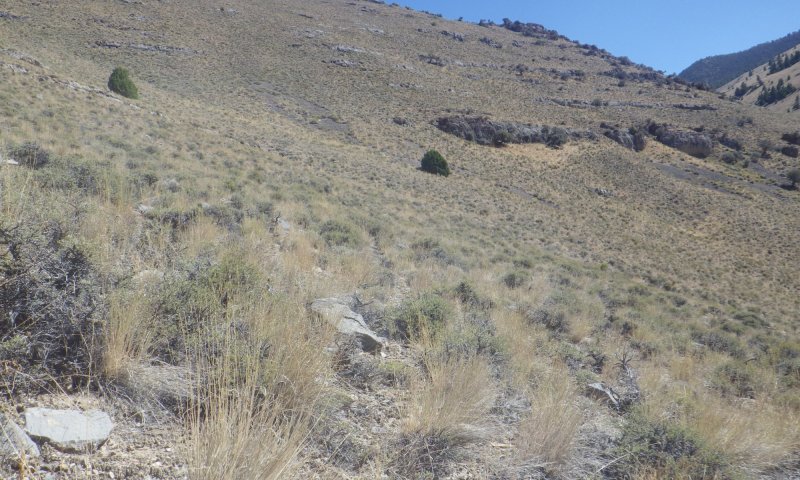
Figure 12. Site ID: 2020ID7031184
The reference state consists of two dominant plant communities: The Black and Little Sagebrush (Artemisia nova & Artemisia arbuscula) dominated community and the Mixed Shrub/Bluebunch Wheatgrass community where overstory shrub canopy dominance is a mix of dwarf sagebrush species, big sagebrush species and other shrubs. The greatest difference between the two plant communities is composition and foliar cover of sagebrush (Artemisia) species. Mountain big sagebrush foliar cover increases on sites that are closer to the high end of the effective precipitation range (10 to 14 inches) and the calcium carbonate equivalency in the soil is lower, closer to minimum 15 percent concentrations outlined in the site concept. Processes (both natural and anthropogenic) that result in state and community changes include fire, grazing, land use change, and occurrence of invasive species (Davies et al., 2011).
Characteristics and indicators. The shift between plant communities at this ecological site is generally driven by calcium carbonate concentration in soils, effective precipitation, and time since disturbance. Historically, low to mixed-severity fires occurred at relatively frequent fire return intervals of 10 to 25 years, limiting sagebrush canopy density and creating a mosaic of sagebrush stands and more open grasslands (Knick, Holmes, & Miller, 2005). Exclusion of fire (in conjunction with climate change) increases sagebrush canopy cover and can lead to more severe stand-replacing fires, oftentimes at more frequent intervals. These severe fires can drive shifts to grassland communities as well as create opportunities for invasive species establishment (Roadhouse, Irvine, & Bowerstock, 2020; Knick et al., 2005). Improper grazing practices can also lead to an increase in sagebrush canopy cover and increased risk of severe, stand replacing fire occurrence. Removal of understory grasses can lessen the opportunities for low severity fires which leads to increased canopy densities and increases potential for severe fire disturbance events (Knick et al., 2005).
Resilience management. This site has moderate resilience as a result of the frigid soil temperature regime and xeric soil moisture regime. Resistance and resilience of a specific site have been attributed to abiotic conditions favorable to plant growth and reproduction (Maestas et al. 2016). Soils that fall within the frigid temperature regime and xeric moisture regime tend to have moderate diversity and production and are therefore more resilient, specifically in terms of resisting or recovering from invasion post-disturbance (Maestas et al., 2016). On the LRU scale, this site may also have increased resistance to invasion of annual grasses due to the calcium carbonate concentration found in the 10 to 25-centimeter range of the soil profile. Calcareous soils have shown to provide a deterrent to the establishment of invasive grasses such as Bromus tectorum (Miller et al., 2006).
Community 1.1
Black and Little Sagebrush and Bluebunch Wheatgrass Community

Figure 13. Site ID: 2020ID7033110
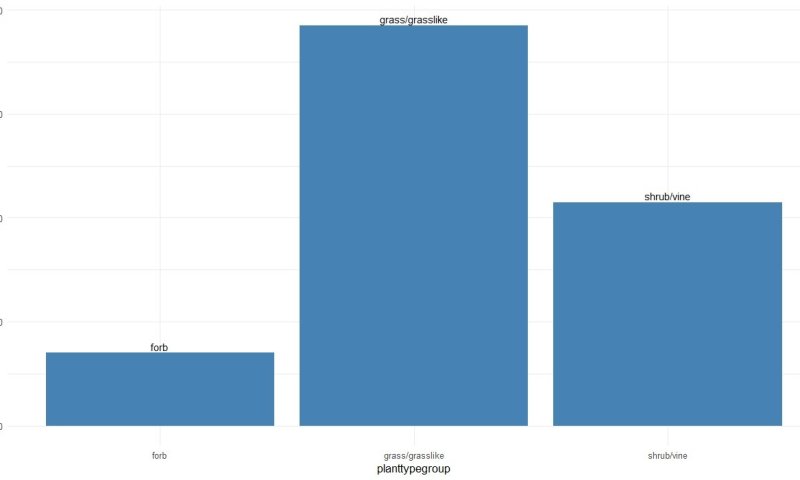
Figure 14. Canopy cover by plant type group: Site ID's: 2020ID7033110, 2021ID7033176.
This community is well adapted to the abiotic conditions of the Lost River Mountain LRU, specifically when soils are shallow to a restrictive layer such as bedrock, clay, or calcareous soils. Black (Artemisia nova) and little (Artemisia arbuscula) sagebrush thrive at dryer sites with soil conditions that create a root-restrictive layer through bedrock or soil chemistry. The more pronounced these conditions become, the more likely the community shifts towards a black sagebrush-dominated community (Tilley & St. John [2], 2012). At the landscape scale, mosaics between little and black sagebrush-dominated sites can represent slight localized differences in soil conditions and effective precipitation (McArthur & Stevens, 2009). Annual production in this community ranges between 400 and 750 pounds per acre, averaging 600 pounds per acre.
Resilience management. This community is moderately resilient. Black sagebrush and bluebunch wheatgrass are both drought-tolerant species, increasing their resistance to climate-related disturbances such as prolonged periods with below-average precipitation. However, with this ecological site occurring in the 10 to 14-inch effective precipitation range, recovery from other disturbances can be slow (Chambers et al., 2014).
Dominant plant species
-
little sagebrush (Artemisia arbuscula ssp. longiloba), shrub
-
black sagebrush (Artemisia nova), shrub
-
bluebunch wheatgrass (Pseudoroegneria spicata), grass
Figure 15. Annual production by plant type (representative values) or group (midpoint values)
Table 7. Annual production by plant type
| Plant type | Low (lb/acre) |
Representative value (lb/acre) |
High (lb/acre) |
|---|---|---|---|
| Grass/Grasslike | 200 | 225 | 450 |
| Shrub/Vine | 200 | 225 | 250 |
| Forb | 25 | 50 | 75 |
| Total | 425 | 500 | 775 |
Table 8. Ground cover
| Tree foliar cover | 0% |
|---|---|
| Shrub/vine/liana foliar cover | 16-25% |
| Grass/grasslike foliar cover | 27-38% |
| Forb foliar cover | 4-8% |
| Non-vascular plants | 0% |
| Biological crusts | 0-5% |
| Litter | 45-73% |
| Surface fragments >0.25" and <=3" | 2-8% |
| Surface fragments >3" | 0-3% |
| Bedrock | 0% |
| Water | 0% |
| Bare ground | 5-15% |
Table 9. Soil surface cover
| Tree basal cover | 0% |
|---|---|
| Shrub/vine/liana basal cover | 1-3% |
| Grass/grasslike basal cover | 2-5% |
| Forb basal cover | 0-2% |
| Non-vascular plants | 0% |
| Biological crusts | 0-8% |
| Litter | 0% |
| Surface fragments >0.25" and <=3" | 20-50% |
| Surface fragments >3" | 0-5% |
| Bedrock | 0% |
| Water | 0% |
| Bare ground | 64-80% |
Figure 16. Plant community growth curve (percent production by month). ID0310, ARARL/FEID/ PSSPS. State 1.
| Jan | Feb | Mar | Apr | May | Jun | Jul | Aug | Sep | Oct | Nov | Dec |
|---|---|---|---|---|---|---|---|---|---|---|---|
| J | F | M | A | M | J | J | A | S | O | N | D |
| 0 | 0 | 5 | 25 | 35 | 20 | 5 | 0 | 5 | 5 | 0 | 0 |
Community 1.2
Mixed Shrub Overstory and Bluebunch Wheatgrass Community
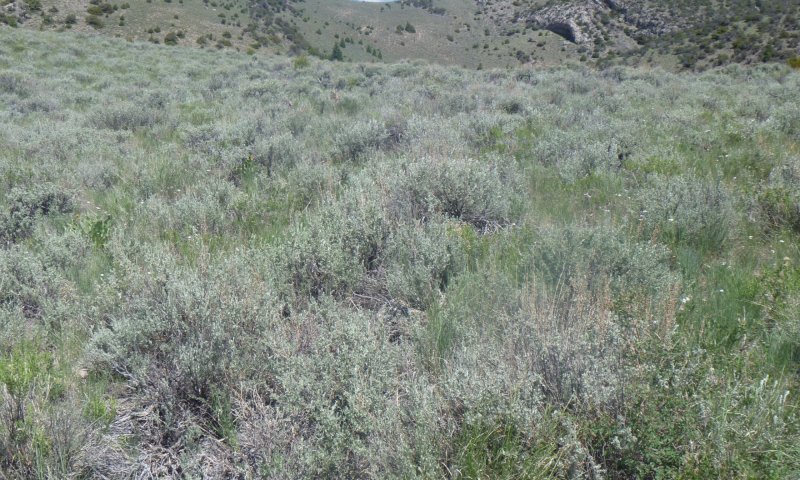
Figure 17. Site ID: 2020ID7032169
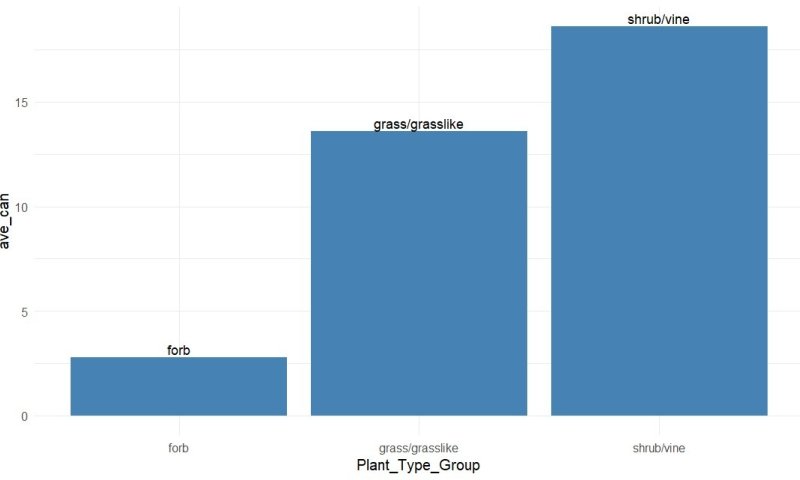
Figure 18. Canopy cover by plant type group.
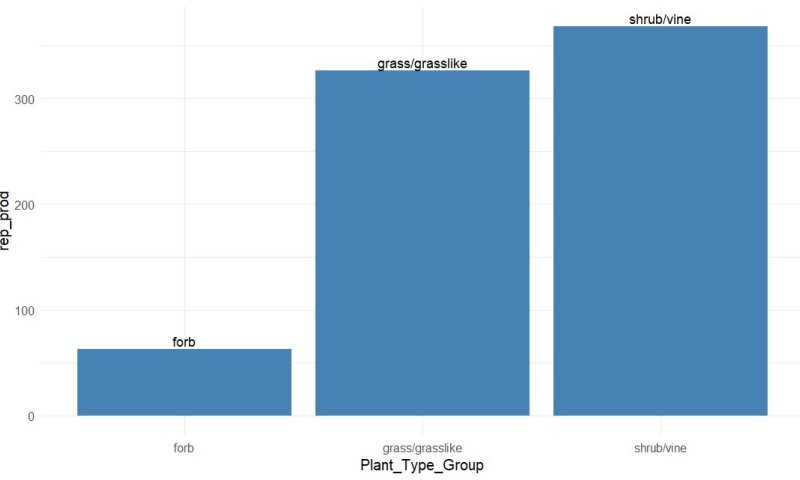
Figure 19. Production by plant type group.
The Mixed Shrub Overstory and Bluebunch Wheatgrass community decreases in little and black sagebrush canopy cover and increases in Wyoming big sagebrush (Artemisia tridentata spp. wyomingensis) and mountain big sagebrush (Artemisia tridentata spp vaseyana) when compared with Community 1.1. Grass and forb composition and canopy cover remain similar to Community 1.1 with a slight increase in production. This community occurs at sites that exist at the higher end of the climatic subset (10 to 14 inches) of the ecological sites' precipitation range. These sites also have a slightly lower concentration of calcium carbonates in the rooting zone of the soil profile, allowing mountain and Wyoming big sagebrush to outcompete little and black sagebrush. Production and canopy cover for this community are more evenly split between shrub and grass plant type groups. Shrub species account for a greater percentage of annual production and canopy cover than grass species. Annual production in this community ranges between 425 and 900 pounds per acre, averaging 750 pounds per acre.
Resilience management. Community 1.2 has moderate resilience. Resilience is gained through the increased diversity in the shrub and forb canopies. However, both big sagebrush species (Wyoming and mountain big sagebrush) are more susceptible to stand-replacing fires than little and black sagebrush-dominated communities. This is due to the increased fine fuel loading that occurs when big sagebrush is present on a site. Mountain big sagebrush and Wyoming big sagebrush are also less resistant to drought when compared with little and black sagebrush.
Dominant plant species
-
big sagebrush (Artemisia tridentata), shrub
-
bluebunch wheatgrass (Pseudoroegneria spicata), grass
Figure 20. Annual production by plant type (representative values) or group (midpoint values)
Table 10. Annual production by plant type
| Plant type | Low (lb/acre) |
Representative value (lb/acre) |
High (lb/acre) |
|---|---|---|---|
| Shrub/Vine | 225 | 375 | 500 |
| Grass/Grasslike | 200 | 325 | 475 |
| Forb | 25 | 75 | 100 |
| Total | 450 | 775 | 1075 |
Table 11. Ground cover
| Tree foliar cover | 0% |
|---|---|
| Shrub/vine/liana foliar cover | 15-26% |
| Grass/grasslike foliar cover | 12-22% |
| Forb foliar cover | 3-7% |
| Non-vascular plants | 0% |
| Biological crusts | 0% |
| Litter | 0% |
| Surface fragments >0.25" and <=3" | 0% |
| Surface fragments >3" | 0% |
| Bedrock | 0% |
| Water | 0% |
| Bare ground | 0% |
Figure 21. Plant community growth curve (percent production by month). ID0605, ARTRW8 -PSSPS . State 1.
| Jan | Feb | Mar | Apr | May | Jun | Jul | Aug | Sep | Oct | Nov | Dec |
|---|---|---|---|---|---|---|---|---|---|---|---|
| J | F | M | A | M | J | J | A | S | O | N | D |
| 0 | 0 | 15 | 25 | 30 | 25 | 0 | 0 | 0 | 5 | 0 | 0 |
Pathway P1-2
Community 1.1 to 1.2


Community transition from community 1.1 to community 1.2 is generally a result of localized abiotic conditions relating to effective precipitation, as well as depth and concentration of calcareous soils. Black sagebrush tends to dominate sites where calcareous soils are stronger and closer to the surface. As calcium carbonate concentrations decrease, deepen, and precipitation conditions become closer to the 14 inch boundary of relative effective annual precipitation, the likelihood of little sage emigrating or becoming dominant increases. As these conditions become really pronounced (nearing transitional areas) mountain big sagebrush (Artemisia tridentata spp. vaseyana) can be present in the overstory.
Context dependence. The abiotic conditions that result in community transitions from 1.1 to 1.2 are site specific and not directly influenced by anthropogenic or biotic interactions.
State 2
Disturbed State
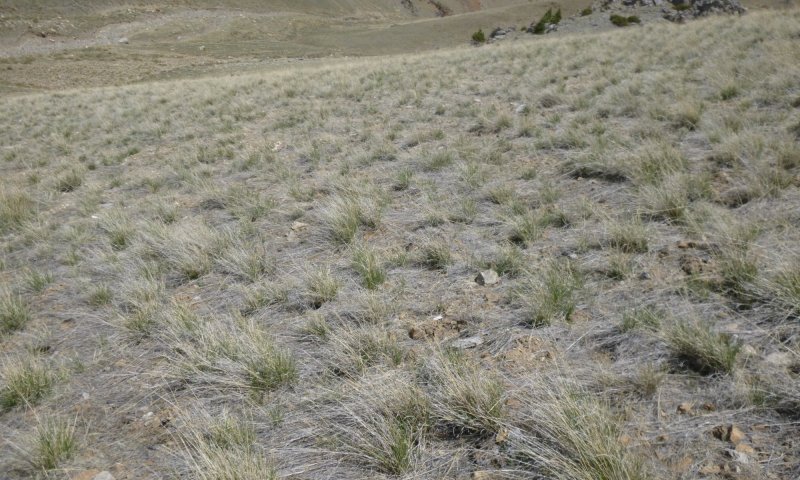
Figure 22. Site ID: 2021ID7033140
The Disturbed state consists of one community and is characterized by a nearly complete to complete loss of overstory shrub canopy. Shrub canopy loss is a result of both natural and anthropogenic disturbances, however, the most common disturbance in this LRU that results in transition to the Disturbed state from the Reference state is moderate to severe fire events. Because this LRU exists primarily on publicly managed lands (US Forest Service, Bureau of Land Management, and State), widespread anthropogenic disturbance events are infrequent. Examples of anthropogenic disturbance events include brush management through sagebrush mowing or removal treatments, chemical treatments, or improper grazing techniques that result in high-intensity hoof disturbance. A combination of natural and anthropogenic disturbance is possible and can result in increased severity of disturbance, decreased resilience, and greater difficulty returning to the Reference State. For example, improper grazing practices that result in chronic defoliation following a fire disturbance event can increase bare ground cover, increase erosion potential, and slow the reestablishment of grass species that preclude the return of overstory sagebrush canopy (Zlatnik, 1999).
Characteristics and indicators. The primary indicator of the Disturbed state is near to complete loss of overstory sagebrush species (black sagebrush, little sagebrush, and mountain big sagebrush). A shift towards an increase in native and non-native disturbance-tolerant grasses and forbs is likely with removal of resource competition associated with sagebrush overstory. Additionally, the canopy cover of disturbance tolerant shrubs such as yellow rabbitbrush (Chrysothamnus viscidiflorus) and rubber rabbitbrush (Ericameria nauseosa) may increase. Severe disturbance events also increase the opportunity for invasion of annual grasses and weeds such as cheatgrass (Bromus tectorum) and thistle species. Percent canopy cover of invasive species is dependent on the distance of a seed source post-disturbance. Initial cover of invasive species stays below 5 percent (Zlatnik, 1999).
Resilience management. Resilience in this state is moderate. Many of the post-disturbance grasses and shrubs that are common in this state establish quickly and reach a representative canopy within 10 years post-disturbance, and continue to increase until the overstory canopy of sagebrush begins to return. However, local resilience in this state is highly dependent on current soil moisture availability, seed sources, timing and severity of the disturbance. In the instance of fire disturbance, bluebunch wheatgrass mortality can be significantly lower if the fire occurs in the spring as opposed to fall, and recovery can be impacted by the quantity of immediate post-fire precipitation (Zlatnik, 1999). More severe disturbances increase the possibility of post-disturbance invasion. The greater the establishment of invasives, the lower the site resilience becomes, and can eventually drive a transition to the Invaded state.
Dominant plant species
-
yellow rabbitbrush (Chrysothamnus viscidiflorus), shrub
-
little sagebrush (Artemisia arbuscula ssp. longiloba), shrub
-
black sagebrush (Artemisia nova), shrub
-
bluebunch wheatgrass (Pseudoroegneria spicata), grass
-
Sandberg bluegrass (Poa secunda), grass
Community 2.1
Bunchgrass and Forb Community

The Mixed Grass and Forb community is driven by the disturbance-related removal of the primary overstory of sagebrush species. Both natural and anthropogenic disturbances that result in complete or near to complete removal of the sagebrush overstory create opportunities for increased establishment and canopy cover of both native and non-native grasses and forbs, as well as disturbance-tolerant shrubs. Fire is the primary disturbance responsible for removing sagebrush at this ecological site. The frequency and severity of fire disturbances are highly influenced by the overstory composition of the specific site in the Reference state. The composition and extent of the sagebrush species in the overstory impacts that respective fire regime. At sites dominated either solely by black sage, alkali sage, or varying combinations of the two, fire return intervals are less frequent. Additionally, fires are usually low to moderate in severity and cover small spatial extents (Steinberg, 2002 & Fryer, 2009). Black and alkali sagebrush-dominated communities often lack fuels sufficient for frequent fire return intervals, severe fire events, or large fire events (Fryer, 2009). Shallow to Loamy Calcareous sites that are at the higher end of the 10 to 14-inch precipitation range with an overstory canopy at least partially comprised of mountain big sagebrush are more susceptible to frequent fire return intervals, more severe fires, and at a greater extent. Sites dominated by mountain big sagebrush communities have historically burned more frequently than sites dominated by other sagebrush species because the soil moisture and temperature regimes required by mountain big sagebrush are also more apt to produce an increased amount of fine fuels from other plant species (Innes, 2017). Production in this community decreases from that of the Reference communities due to the loss of shrub overstory, however, production in the grass and forb functional groups increases. Production ranges from 225 to 700 pounds per acre, averaging 450 pounds per acre.
Resilience management. This plant community is moderately resilient because the grasses and forbs that dominate the composition are resistant to a variety of disturbances and able to re-establish quickly in the event of more severe disturbances. Both bluebunch wheatgrass (Pseudoroegenaria spicata) and Sandberg's bluegrass (Poa secunda) are rarely harmed by fire events except for in the most severe instances. Both species are able to reduce the amount of heat transfer to the root systems, allowing post-fire regrowth (Zlatnik, 1999 & Howard, 1997). Studies have shown that in the absence of grazing, bluebunch wheatgrass-dominated systems are able to return to pre-fire production levels eight years post-disturbance (Zlatnick, 1999) Although many of the species in this state are at least somewhat resilient towards many of the disturbances encountered, available soil moisture, weather, and rest from grazing all play an important role in how quickly a site can recover post-disturbance. Both of the common shrub species found in this community at varying compositions are not only disturbance tolerant but tend to increase with disturbance. Both yellow rabbitbrush and rubber rabbitbrush are often the first shrub species to re-establish on this ecological site following a disturbance and can increase in relation to the severity or frequency of the disturbance. Although yellow rabbitbrush exists in relatively small numbers within the Reference State, it can only become the dominant shrub species in highly disturbed systems (Terminstein, 1999).
Dominant plant species
-
yellow rabbitbrush (Chrysothamnus viscidiflorus), shrub
-
rubber rabbitbrush (Ericameria nauseosa), shrub
-
bluebunch wheatgrass (Pseudoroegneria spicata), grass
-
Sandberg bluegrass (Poa secunda), grass
Figure 23. Annual production by plant type (representative values) or group (midpoint values)
Table 12. Annual production by plant type
| Plant type | Low (lb/acre) |
Representative value (lb/acre) |
High (lb/acre) |
|---|---|---|---|
| Grass/Grasslike | 150 | 300 | 425 |
| Shrub/Vine | 0 | 75 | 150 |
| Forb | 25 | 50 | 100 |
| Total | 175 | 425 | 675 |
Table 13. Ground cover
| Tree foliar cover | 0% |
|---|---|
| Shrub/vine/liana foliar cover | 0-10% |
| Grass/grasslike foliar cover | 15-40% |
| Forb foliar cover | 0-10% |
| Non-vascular plants | 0% |
| Biological crusts | 0% |
| Litter | 5-35% |
| Surface fragments >0.25" and <=3" | 0-15% |
| Surface fragments >3" | 0-5% |
| Bedrock | 0% |
| Water | 0% |
| Bare ground | 0-15% |
Table 14. Soil surface cover
| Tree basal cover | 0% |
|---|---|
| Shrub/vine/liana basal cover | 0-2% |
| Grass/grasslike basal cover | 2-7% |
| Forb basal cover | 0-2% |
| Non-vascular plants | 0% |
| Biological crusts | 0% |
| Litter | 0% |
| Surface fragments >0.25" and <=3" | 3-40% |
| Surface fragments >3" | 0-10% |
| Bedrock | 0% |
| Water | 0% |
| Bare ground | 40-75% |
State 3
Invaded State
When a Shallow to Loamy, Calcareous ecological site transitions to the Invaded state, it is a result of post disturbance invasion by non-native and invasive species. This state can be driven by a particularly severe disturbance either in the form of frequent or severe fire, intensive grazing that results in chronic defoliation of vegetation, land use, or repeated disturbances of low to moderate severity over short periods of time. Proximity to seed source as well as seed transport vectors play a role in likelihood of post disturbance invasion.
Characteristics and indicators. In this state, total canopy cover and production values for mid to large-sized bunchgrasses such as bluebunch wheatgrass will decrease. Traditional overstory cover and production of black sagebrush, little sagebrush, big sagebrush, and other shrubs will also decrease. These openings in the canopy will be filled with invasive annuals such as cheatgrass (Bromus techtorum) and more disturbance-tolerant forbs such as phlox species, vetch species, and Indian paintbrush (Castilleja sp.). Continued disturbance will increase cover and production of these species. Productivity and canopy cover is lower than the reference state and shifted towards the understory grass species and forbs, particularly the invasive annuals.
Resilience management. This site has low resilience primarily due to the invasive species establishment. Cheatgrass is well adapted to post disturbance establishment, particularly after wildfire disturbances. Cheatgrass takes advantage of prolific seedbanks resilient to fire and ability to rapidly establish when competition from native vegetation has been removed. Additionally, cheatgrass is able to alter fire regimes, shortening fire return intervals which provides a further advantage for cheatgrass and hinders re-establishment of native vegetation (Zouhar, 2003). Once fully established, restoration of sites invaded by cheatgrass either through natural or mechanical means has low success rates.
Dominant plant species
-
little sagebrush (Artemisia arbuscula ssp. longiloba), shrub
-
black sagebrush (Artemisia nova), shrub
-
big sagebrush (Artemisia tridentata), shrub
-
cheatgrass (Bromus tectorum), grass
-
bluebunch wheatgrass (Pseudoroegneria spicata), grass
-
phlox (Phlox), other herbaceous
-
stemless mock goldenweed (Stenotus acaulis), other herbaceous
Community 3.1
Invasive Grass and Forb Community
The Invasive Grass and Forb Community become dominant on a site in the Invaded state where native vegetation has been removed or severely altered by either natural or anthropogenic disturbances. Once cheatgrass has been established, the species can outcompete the native vegetation that it replaced and promote feedback loops (such as shortened fire return intervals) that help perpetuate dominance (Zouhar, 2003). Although much of the shrub overstory from the Reference state is removed, yellow rabbitbrush is able to take advantage of its ability to aggressively sprout and rapidly grow following a disturbance. Once established in the overstory, yellow rabbitbrush needs continued frequent disturbances to stay dominant in the shrub overstory. In the absence of disturbance, yellow rabbitbrush will remain dominant for about 15 years before beginning to be replaced by shrub species from the reference community. The level of invasive species establishment is dependent on the severity of disturbances, amount of remaining native vegetation, and distance and transmission mechanisms for invasive species seed sources. Production in this community is moderately low, and may not consist of desirable grazing species. Production ranges from 300 to 650 pounds per acre, averaging 500 pounds per acre.
Resilience management. This site has high resilience as it is primarily disturbance-driven. The dominant overstory and understory species are highly disturbance tolerant. Frequent disturbance regimes tend to perpetuate the dominance of this community.
Dominant plant species
-
yellow rabbitbrush (Chrysothamnus viscidiflorus), shrub
-
bluebunch wheatgrass (Pseudoroegneria spicata), grass
-
cheatgrass (Bromus tectorum), grass
Figure 24. Annual production by plant type (representative values) or group (midpoint values)
Table 15. Annual production by plant type
| Plant type | Low (lb/acre) |
Representative value (lb/acre) |
High (lb/acre) |
|---|---|---|---|
| Grass/Grasslike | 175 | 200 | 325 |
| Shrub/Vine | 50 | 125 | 200 |
| Forb | 50 | 75 | 125 |
| Total | 275 | 400 | 650 |
Table 16. Ground cover
| Tree foliar cover | 0% |
|---|---|
| Shrub/vine/liana foliar cover | 10-18% |
| Grass/grasslike foliar cover | 14-33% |
| Forb foliar cover | 3-10% |
| Non-vascular plants | 0% |
| Biological crusts | 0% |
| Litter | 10-45% |
| Surface fragments >0.25" and <=3" | 3-15% |
| Surface fragments >3" | 0-5% |
| Bedrock | 0% |
| Water | 0% |
| Bare ground | 0-15% |
Table 17. Soil surface cover
| Tree basal cover | 0% |
|---|---|
| Shrub/vine/liana basal cover | 1-3% |
| Grass/grasslike basal cover | 2-5% |
| Forb basal cover | 0-2% |
| Non-vascular plants | 0% |
| Biological crusts | 0% |
| Litter | 0% |
| Surface fragments >0.25" and <=3" | 5-35% |
| Surface fragments >3" | 0-10% |
| Bedrock | 0% |
| Water | 0% |
| Bare ground | 40-75% |
Transition T1-2
State 1 to 2


Transition from the Reference to the Disturbed state is primarily a mechanism of severe disturbance, both natural and anthropogenic. In this this ecological site, the most likely disturbance to cause this transition is frequent or severe wildfire events. Other disturbances include but are not limited to freeze kill, insect and disease, and mechanical brush removal.
Constraints to recovery. Primary constraint to recovery is distance to seed source. When the disturbance is severe enough and the extent is great, seed source populations for sagebrush species may be removed from the vicinity. In this case, immigration and re-establishment of overstory sagebrush species can be slow. This time period can be greatly reduced through seeding and planting interventions.
Context dependence. The primary factor driving likelihood of restoration success is post disturbance weather patterns. Prolonged period of drought can slow restoration processes, whereas average to above average precipitation post disturbance can greatly increase speed and success in re-establishment of sagebrush species (Robin, 2017; Steinberg, 2002; and Fryer, 2009).
Transition T1-3
State 1 to 3
The transition from the reference state to the Degraded state is primarily a mechanism of severe disturbance and post disturbance establishment of invasive species. The most likely disturbance events in this LRU associated with transition to this state are severe or frequent wildfire events and repeated overgrazing that results in chronic defoliation. Following a severe disturbance, invasive and disturbance tolerant species will rapidly establish, preventing native vegetation from recovering. Other possible disturbances include but are not limited to freeze kill events, insect and disease, and mechanical brush removal.
Constraints to recovery. The most significant constraint to recovery in this state is establishment of non-native vegetation and disturbance tolerant plants. Once established, these species are able to outcompete native vegetation preventing those species from recovering to pre-disturbance levels. Effective treatment options are limited once significant populations of cheatgrass have established. Using prescribed or natural fire in conjunction with post fire seeding of native vegetation has shown success, however, reverting to cheatgrass canopy covers under five percent and returning to the reference state is highly unlikely (Zouhar, 2003).
Restoration pathway R2-1
State 2 to 1


The most important mechanism driving restoration from the Disturbed to the Reference State is time without sagebrush removing disturbances and distance from overstory species (sagebrush) seed source. Seeding or planting of desired overstory species in the Reference State can accelerate restoration efforts.
Context dependence. Restoration is highly dependent on time without disturbance. New sagebrush seedlings that are able to establish on a site are moderately sensitive to disturbances such as flood, freeze, and insect and disease. They are highly sensitive to herbivory and even low severity fire occurrence (Fryer, 2009 & Steinberg 2002). Seeding and planting of desired species can speed up the restoration process, however, regeneration success with or without planting is highly dependent on localized weather patterns during this restoration period. Periods of drought will slow the process significantly, whereas periods of above normal precipitation aid in sagebrush regeneration and establishment (Innes, 2017; Steinberg 2002 & Fryer, 2009).
Transition T2-3
State 2 to 3
Transition from the Disturbed state to the Invaded state occurs when non-native and invasive species are able to establish in place of native vegetation following a disturbance. Invasive species such as cheatgrass are able to take advantage of the available canopy space and resources that result from removal of native vegetation following a disturbance. The speed and extent of invasive species establishment is dependent on the severity of the disturbance, distance from invasive species seed sources, and dispersal methods of invasive species.
Constraints to recovery. The most significant constraint to recovery in this state is establishment of non-native vegetation and disturbance tolerant plants. Once established, these species are able to outcompete native vegetation preventing those species from recovering to pre-disturbance levels. Often the species in this state disrupt disturbance regimes in a way that promotes further establishment . Effective treatment options are limited once significant populations of cheatgrass have established. Using prescribed or natural fire in conjunction with post fire seeding of native vegetation has shown success, however, reverting to cheatgrass canopy covers under five percent and returning to the reference state is highly unlikely (Zouhar, 2003).
Restoration pathway R3-1
State 3 to 1
Restoration from the Invaded state to the Reference state is resource intensive and often unsuccessful, especially when cheatgrass is the primary invasive species. Once populations of invasive species exceed five percent canopy cover, mechanical and chemical treatments are required to effectively treat a site. Seeding or planting of native species following treatments is necessary to avoid re-invasion by non-desirable species.
Context dependence. Restoration success is dependent on invasive species composition and level of establishment. Removal of cheat grass once significant establishment occurs can be resource intensive with low success rates.
Additional community tables
Table 18. Community 1.1 plant community composition
| Group | Common name | Symbol | Scientific name | Annual production (lb/acre) | Foliar cover (%) | |
|---|---|---|---|---|---|---|
|
Shrub/Vine
|
||||||
| 1 | 200–250 | |||||
| little sagebrush | ARARL | Artemisia arbuscula ssp. longiloba | 119–208 | 10–16 | ||
| black sagebrush | ARNO4 | Artemisia nova | 125–200 | 7–13 | ||
| rubber rabbitbrush | ERNA10 | Ericameria nauseosa | 19–42 | 2–5 | ||
| yellow rabbitbrush | CHVI8 | Chrysothamnus viscidiflorus | 15–40 | 1–4 | ||
| mountain big sagebrush | ARTRV | Artemisia tridentata ssp. vaseyana | 0–25 | 0–2 | ||
| common juniper | JUCO6 | Juniperus communis | 0–25 | 0–2 | ||
| Rocky Mountain juniper | JUSC2 | Juniperus scopulorum | 0–25 | 0–2 | ||
| curl-leaf mountain mahogany | CELE3 | Cercocarpus ledifolius | 0–20 | 0–2 | ||
| shadscale saltbush | ATCO | Atriplex confertifolia | 0–20 | 0–2 | ||
| slender buckwheat | ERMI4 | Eriogonum microthecum | 0–15 | 0–2 | ||
| mountain snowberry | SYOR2 | Symphoricarpos oreophilus | 0–15 | 0–1 | ||
|
Grass/Grasslike
|
||||||
| 2 | 200–450 | |||||
| bluebunch wheatgrass | PSSP6 | Pseudoroegneria spicata | 147–413 | 15–30 | ||
| bluegrass | POA | Poa | 0–85 | 0–6 | ||
| Sandberg bluegrass | POSE | Poa secunda | 30–75 | 3–8 | ||
| Indian ricegrass | ACHY | Achnatherum hymenoides | 10–35 | 1–3 | ||
| spike fescue | LEKI2 | Leucopoa kingii | 0–25 | 0–2 | ||
|
Forb
|
||||||
| 3 | 25–75 | |||||
| spiny phlox | PHHO | Phlox hoodii | 15–30 | 2–4 | ||
| hawksbeard | CREPI | Crepis | 10–25 | 1–3 | ||
| stemless mock goldenweed | STAC | Stenotus acaulis | 10–20 | 1–2 | ||
| buckwheat | ERIOG | Eriogonum | 10–20 | 1–2 | ||
| ballhead sandwort | ARCO5 | Arenaria congesta | 0–15 | 0–2 | ||
| Indian paintbrush | CASTI2 | Castilleja | 10–15 | 1–2 | ||
| bushy bird's beak | CORA5 | Cordylanthus ramosus | 0–15 | 0–1 | ||
| cushion buckwheat | EROV | Eriogonum ovalifolium | 0–15 | 0–1 | ||
| prickly sandwort | ARAC2 | Arenaria aculeata | 0–10 | 0–1 | ||
| cutleaf daisy | ERCO4 | Erigeron compositus | 0–10 | 0–1 | ||
| beardtongue | PENST | Penstemon | 0–10 | 0–1 | ||
| sego lily | CANU3 | Calochortus nuttallii | 0–10 | 0–1 | ||
| rockcress | ARABI2 | Arabis | 0–10 | 0–1 | ||
Table 19. Community 1.2 plant community composition
| Group | Common name | Symbol | Scientific name | Annual production (lb/acre) | Foliar cover (%) | |
|---|---|---|---|---|---|---|
|
Shrub/Vine
|
||||||
| 1 | 230–490 | |||||
| mountain big sagebrush | ARTRV | Artemisia tridentata ssp. vaseyana | 150–350 | 8–22 | ||
| Wyoming big sagebrush | ARTRW8 | Artemisia tridentata ssp. wyomingensis | 150–350 | 8–22 | ||
| little sagebrush | ARARL | Artemisia arbuscula ssp. longiloba | 40–125 | 2–7 | ||
| rubber rabbitbrush | ERNA10 | Ericameria nauseosa | 30–100 | 2–6 | ||
| yellow rabbitbrush | CHVI8 | Chrysothamnus viscidiflorus | 25–55 | 2–4 | ||
| black sagebrush | ARNO4 | Artemisia nova | 0–55 | 0–4 | ||
| threetip sagebrush | ARTR4 | Artemisia tripartita | 0–25 | 0–3 | ||
| mountain snowberry | SYOR2 | Symphoricarpos oreophilus | 0–20 | 0–2 | ||
|
Grass/Grasslike
|
||||||
| 2 | 190–470 | |||||
| bluebunch wheatgrass | PSSP6 | Pseudoroegneria spicata | 118–352 | 7–18 | ||
| Sandberg bluegrass | POSE | Poa secunda | 50–100 | 4–8 | ||
| prairie Junegrass | KOMA | Koeleria macrantha | 10–60 | 1–5 | ||
| bluegrass | POA | Poa | 0–50 | 0–4 | ||
| crested wheatgrass | AGCR | Agropyron cristatum | 0–15 | 0–1 | ||
|
Forb
|
||||||
| 3 | 25–90 | |||||
| phlox | PHLOX | Phlox | 15–40 | 2–5 | ||
| lupine | LUPIN | Lupinus | 0–35 | 0–2 | ||
| aster | ASTER | Aster | 10–30 | 2–4 | ||
| pussytoes | ANTEN | Antennaria | 10–30 | 1–3 | ||
| Indian paintbrush | CASTI2 | Castilleja | 10–25 | 1–3 | ||
| stemless mock goldenweed | STAC | Stenotus acaulis | 10–25 | 1–2 | ||
| arrowleaf balsamroot | BASA3 | Balsamorhiza sagittata | 0–20 | 0–2 | ||
| western stoneseed | LIRU4 | Lithospermum ruderale | 0–15 | 0–2 | ||
| meadow deathcamas | ZIVE | Zigadenus venenosus | 0–15 | 0–2 | ||
| milkvetch | ASTRA | Astragalus | 0–10 | 0–1 | ||
| larkspur | DELPH | Delphinium | 0–10 | 0–1 | ||
| yellow salsify | TRDU | Tragopogon dubius | 0–10 | 0–1 | ||
| ragwort | SENEC | Senecio | 0–10 | 0–1 | ||
Table 20. Community 2.1 plant community composition
| Group | Common name | Symbol | Scientific name | Annual production (lb/acre) | Foliar cover (%) | |
|---|---|---|---|---|---|---|
|
Shrub/Vine
|
||||||
| 1 | 0–150 | |||||
| yellow rabbitbrush | CHVI8 | Chrysothamnus viscidiflorus | 15–100 | 2–8 | ||
| threetip sagebrush | ARTR4 | Artemisia tripartita | 0–50 | 0–4 | ||
| black sagebrush | ARNO4 | Artemisia nova | 0–50 | 0–3 | ||
| little sagebrush | ARARL | Artemisia arbuscula ssp. longiloba | 0–50 | 0–3 | ||
| big sagebrush | ARTR2 | Artemisia tridentata | 0–40 | 0–3 | ||
| rubber rabbitbrush | ERNA10 | Ericameria nauseosa | 10–35 | 1–3 | ||
|
Grass/Grasslike
|
||||||
| 2 | 150–425 | |||||
| bluebunch wheatgrass | PSSP6 | Pseudoroegneria spicata | 50–200 | 5–20 | ||
| Sandberg bluegrass | POSE | Poa secunda | 15–115 | 2–14 | ||
| needlegrass | ACHNA | Achnatherum | 0–75 | 0–6 | ||
| Indian ricegrass | ACHY | Achnatherum hymenoides | 0–75 | 0–6 | ||
| cheatgrass | BRTE | Bromus tectorum | 0–35 | 0–4 | ||
|
Forb
|
||||||
| 3 | 25–100 | |||||
| stemless mock goldenweed | STAC | Stenotus acaulis | 5–20 | 1–3 | ||
| Indian paintbrush | CASTI2 | Castilleja | 5–20 | 1–3 | ||
| hawksbeard | CREPI | Crepis | 5–20 | 1–3 | ||
| spiny phlox | PHHO | Phlox hoodii | 5–20 | 1–3 | ||
| fleabane | ERIGE2 | Erigeron | 0–15 | 0–2 | ||
Table 21. Community 3.1 plant community composition
| Group | Common name | Symbol | Scientific name | Annual production (lb/acre) | Foliar cover (%) | |
|---|---|---|---|---|---|---|
|
Shrub/Vine
|
||||||
| 1 | 50–200 | |||||
| yellow rabbitbrush | CHVI8 | Chrysothamnus viscidiflorus | 25–125 | 2–9 | ||
| rubber rabbitbrush | ERNA10 | Ericameria nauseosa | 0–50 | 0–3 | ||
| big sagebrush | ARTR2 | Artemisia tridentata | 0–45 | 0–2 | ||
| little sagebrush | ARARL | Artemisia arbuscula ssp. longiloba | 0–35 | 0–2 | ||
| black sagebrush | ARNO4 | Artemisia nova | 0–35 | 0–2 | ||
|
Grass/Grasslike
|
||||||
| 2 | 175–325 | |||||
| bluebunch wheatgrass | PSSP6 | Pseudoroegneria spicata | 75–200 | 5–17 | ||
| cheatgrass | BRTE | Bromus tectorum | 35–150 | 5–15 | ||
| Sandberg bluegrass | POSE | Poa secunda | 15–100 | 1–10 | ||
| needlegrass | ACHNA | Achnatherum | 0–50 | 0–4 | ||
| Indian ricegrass | ACHY | Achnatherum hymenoides | 0–45 | 0–4 | ||
|
Forb
|
||||||
| 3 | 50–125 | |||||
| spotted knapweed | CEST8 | Centaurea stoebe | 0–25 | 0–4 | ||
| rush skeletonweed | CHJU | Chondrilla juncea | 0–25 | 0–4 | ||
| phlox | PHLOX | Phlox | 5–25 | 1–3 | ||
| stemless mock goldenweed | STAC | Stenotus acaulis | 5–20 | 1–3 | ||
| Indian paintbrush | CASTI2 | Castilleja | 5–15 | 1–2 | ||
| hawksbeard | CREPI | Crepis | 0–15 | 0–2 | ||
| common dandelion | TAOF | Taraxacum officinale | 0–15 | 0–2 | ||
Interpretations
Animal community
Listed below are production ranges for each community in the Shallow to Loamy, Calcareous 10 - 14 Inch Precipitation Zone ecological site. Production ranges can be used to estimate stocking rates; however, community composition as listed in this ecological site description may not entirely match the current composition at a given site. Field visits to document actual plant composition and production should be conducted to calculate actual stocking rates at any specific location.
Communities and Production Ranges (in pounds per acre) for each state and Community are as follows: In the Reference state, Community 1.1 has a range of 400 to 750, averaging 600; Community 1.2 has a range of 425 to 900, averaging 750. In the Disturbed state, Community 2.1 ranges from 225 to 700, averaging 450. In the Invaded state, Community 3.1 ranges from 300 to 650, averaging 500.
Wildlife Interpretations:
Sagebrush steppe ecosystems in the Western United States cover nearly 165 million acres and provide vital habitat for over 170 different species of birds and mammals (NWF, 2022).
The sagebrush steppe in the Lost River Mountain LRU provide critical winter range for mule deer, elk, pronghorn and moose. The LRU also encompasses critical habitat for greater sage grouse populations in the Lemhi, Lost River, and White Knob Mountains. Sage grouse priority planning areas have been identified by the Challis Sage Grouse Local Working Group (CSLWG) in Grouse and Morse Creek, the Upper Pahsimeroi north of Sawmill Canyon, Mackay Bar, and Barton Flats (CSLWG, 2007). According to Idaho Fish and Game Management spatial layers developed in conjunction with the Bureau of Land Management, US Forest Service, and US Fish and Wildlife Service, greater sage grouse general habitat exists on the northern end of the White Knob Mountain range, northern end of the Pahsimeroi mountain range, and portions of the eastern side of the Lemhi and White Knob mountain ranges. More importantly to the species, significant areas designated important and priority habitat have been identified across the entirety of the White Knob, Lost River, and Lemhi mountain ranges.
The following are dominant plant species within this ecological site and their associated value to wildlife present in the LRU:
Black sagebrush (Artemisia nova):
Mule deer and pronghorn use black sagebrush habitats extensively. Use is especially heavy by mule deer in the early decades post-fire disturbance (communities 1.3 and 3.1). This is most prevalent within the first three decades after the fire event (Fryer, 2009). Black sagebrush-dominated sites have been shown as great winter range for pronghorn (Kindschy et al., 1982) and winter distribution has been strongly associated with black sagebrush communities (Clary & Beale, 1983). Sage grouse are obligate species of black and other sagebrush varieties. Generally, big sagebrush communities are preferred by sage grouse; however, some black sagebrush sites on the Snake River Plains and in Nevada have shown to be preferred winter grounds for feeding and cover (Dalke et al., 1963).
Other species of note that rely on black sagebrush communities include great basin pocket mice, Ord's kangaroo rats, sage thrashers, and a large variety of insect pollinator species (Fryer, 2009).
Little sagebrush (Artemisia arbuscula longiloba):
In early spring and winter, little sagebrush is often a preferred forage species for mule deer (Blaisdell et al., 1982). In the Great Basin, little sagebrush dominated sites are heavily utilized by pronghorn during the summer (Kindschy et al., 1982). Little sagebrush, among other varieties is an important forage source for sage grouse throughout the year (Steinberg, 2002).
Mountain big sagebrush (Artemisia tridentata vaseyana):
Mountain big sagebrush is considered to be highly palatable by most wildlife browsers (Rosenstrater, 2005). Sage -grouse, ungulates, and rodents browse mountain big sagebrush primarily during the winter when it becomes one of the more palatable available forages. However, seasonal snow levels can exclude many browsing species. Several studies have shown that mountain big sagebrush is preferred forage by elk, mule deer, and sage-grouse when compared to the other big sagebrush species (Innes, 2017).
Bluebunch wheatgrass (Psuedoeogenaria spicata):
Bluebunch wheatgrass is considered one of the most important forage species on western rangelands for both livestock and wildlife (Sours, 1983). In Idaho, use of bluebunch wheatgrass by elk was medium-high, medium for mule deer, high for bighorn sheep, and low for pronghorn (Zlatnik, 1999).
Sandberg bluegrass (Poa secunda):
Sandberg bluegrass is one of the earliest grasses to green up during the spring and become available forage for wildlife, however, becomes less utilized during the later summer months. The degree of use by elk and pronghorn is good to poor and good to fair for mule deer, small mammals, small nongame birds, and upland game birds. Usage is fair to poor by waterfowl (Howard, 1997).
Hydrological functions
Water in the form of annual precipitation is the primary limiting factor of total plant production on this ecological site. Soils associated with this site are primarily associated with hydrologic group B. Runoff potential ranges from moderate to rapid and soil permeability is moderate. Water transmission through the soil is unimpeded.
Higher infiltration rates and lower runoff rates tend to coincide with ground cover percentage. Reduced infiltration and increased runoff have the greatest potential when ground cover is less than 50 percent.
Recreational uses
This ecological site provides hunting opportunities for upland game birds and large game animals including pronghorn, mule deer, elk, and moose. Many trails and campsites exist within the LRU and are maintained by public land management agencies.
The diverse plants that exist in this LRU and on this ecological site have an aesthetic value that appeals to recreationists.
Supporting information
Inventory data references
Site ID's and data collection intensity for each site used in the development of this ecological site description are listed below. Tier III data sets include five rangeland inventory protocols: Line point intercept, canopy/basal gap, production, continuous line intercept for overstory canopy, and soil stability. Tier II datasets include Line point intercept and at least one other survey. Tier I datasets include an ocular macroplot survey that involved a site plant census, canopy cover estimates, production by species estimates, and total site production estimates.
Reference State:
Community 1.1:
Tier III - 2020ID7033110, 2021ID7033176
Tier I - 2020ID7031184, 2021ID7033143, 2021ID7033144, 2021ID7033166
Community 1.2:
Tier I - 2020ID7032169, 2020ID7032170, 2020ID7032223, 2021ID7033201, 2021ID7033202
Community 2.1:
Tier I - 2021ID7033140
Other references
Blaisdell, James P.; Murray, Robert B.; McArthur, E. Durant. 1982. Managing Intermountain rangelands--sagebrush-grass ranges. Gen. Tech. Rep. INT-134. Ogden, UT: U.S. Department of Agriculture, Forest Service, Intermountain Forest and Range Experiment Station. 41 p.
Challis Sage-grouse Local Working Group (CSLWG). 2007. Challis Sage-grouse Conservation Plan.
Chambers, J.C., J.L. Beck, T.J. Christiansen, K.J. Clause, J.B. Dinkins, K.E. Doherty, K.A. Griffin, D.W. Havlina, K.F. Henke, L.L. Kurth, J.D. Maestas, M. Manning, K.E. Mayer, B.A. Mealor, C. McCarthy, M.A. Perea, and D.A. Pyke. 2016. Using resilience and resistance concepts to manage threats to sagebrush ecosystems, Gunnison sage-grouse, and Greater sage-grouse in their eastern range: A strategic multi-scale approach.. Gen. Tech. Rep. RMRS-GTR-356.. U.S. Department of Agriculture, Forest Service, Rocky Mountain Research Station, Fort Collins, CO. 1–143.
Chambers, J.C., D.A. Pyke, J.D. Maestas, M. Pellant, C.S. Boyd, S.B. Campbell, S. Esipinosa, D.W. Havlina, K.E. Mayer, and A. Wuenschel. 2014. Using resistance and resilience concepts to reduce impacts of invasive annual grasses and altered fire regimes on the sagebrush ecosystem and greater sage-grouse: A strategic multi-scale approach.. Gen. Tech. Rep. RMRS-GTR-326.. U.S. Department of Agriculture, Forest Service, Rocky Mountain Research Station., Fort Collins, CO. 73.
Clary, Warren P.; Beale, Donald M. 1983. Pronghorn reactions to winter sheep grazing, plant communities, and topography in the Great Basin. Journal of Range Management. 36(6): 749-752.
Dalke, Paul D.; Pyrah, Duane B.; Stanton, Don C.; Crawford, John E.; Schlatterer, Edward F. 1963. Ecology, productivity, and management of sage grouse in Idaho. Journal of Wildlife Management. 27(4): 810-841.
Fryer, Janet L. 2009. Artemisia nova. In: Fire Effects Information System, [Online]. U.S. Department of Agriculture, Forest Service, Rocky Mountain Research Station, Fire Sciences Laboratory (Producer). Available: https://www.fs.usda.gov/database/feis/plants/shrub/artnov/all.html
Howard, Janet L. 1997. Poa secunda. In: Fire Effects Information System, [Online].
U.S. Department of Agriculture, Forest Service, Rocky Mountain Research Station,
Fire Sciences Laboratory (Producer). Available:
https://www.fs.usda.gov/database/feis/plants/graminoid/poasec/all.html
Innes, Robin J. 2017. Artemisia tridentata subsp. vaseyana, mountain big sagebrush. In: Fire Effects Information System, [Online]. U.S. Department of Agriculture, Forest Service, Rocky Mountain Research Station, Missoula Fire Sciences Laboratory (Producer). Available: https://www.fs.usda.gov/database/feis/plants/shrub/arttriv/all.html
Kindschy, Robert R.; Sundstrom, Charles; Yoakum, James D. 1982. Wildlife habitats in managed rangelands--the Great Basin of southeastern Oregon: pronghorns. Gen. Tech. Rep. PNW-145. Portland, OR: U.S. Department of Agriculture, Forest Service. 18 p.
Knick, S.T.; Holmes, A.L.; Miller, Richard F. 2005. The role of fire in structuring sagebrush habitats and bird communities. Pages 63-75 In: Saab, Victoria A.; Powell, Hugh D. W. (eds.). Fire and Avian Ecology in North America. Studies in Avian Biology No. 30. Camarillo, CA: Cooper Ornithological Society.
McArthur and Stevens. 2009. Composite Shrubs. In: S.B. Monsen, R. Stevens, and N.L. Shaw [compilers]. Restoring western ranges and wildlands. Fort Collins, CO: USDA Forest Service, Rocky Mountain Research Station. General Technical Report RMRSGTR-136-vol-2. p. 493-537.
Miller, M., Belnap, J., Beatty, S., Reynolds, R. (2006). Performance of Bromus tectorum L. in Relation to Soil Properties, Water Additions, and Chemical Amendments in Calcareous Soils of Southeastern Utah, USA. Canyonlands Research. 288. 10.1007/s11104-006-0058-4.
National Wildlife Federation (NWF). 2022. Sagebrush Steppe. Retrieved from: https://www.nwf.org/Educational-Resources/Wildlife-Guide/Threats-to-Wildlife/Climate-Change/Habitats/Sagebrush-Steppe.
Sours, John M. 1983. Characteristics and uses of important grasses for arid western rangelands. In: Monsen, Stephen B.; Shaw, Nancy, compilers. Managing Intermountain rangelands--improvement of range and wildlife habitats: Proceedings of a symposia; 1981 September 15-17; Twin Falls, ID; 1982 June 22-24; Elko, NV. Gen. Tech. Rep. INT-157. Ogden, UT: U.S. Department of Agriculture, Forest Service, Intermountain Forest and Range Experiment Station: 90-94.
Steinberg, Peter D. 2002. Artemisia arbuscula. In: Fire Effects Information System, [Online]. U.S. Department of Agriculture, Forest Service, Rocky Mountain Research Station, Fire Sciences Laboratory (Producer). Available: https://www.fs.usda.gov/database/feis/plants/shrub/artarb/all.html
TIlley, D. and L. St. John [1]. 2012. Plant Guide for black sagebrush (Artemisia nova). USDA-Natural Resources Conservation Service, Aberdeen Plant Materials Center. Aberdeen, Idaho 83210.
TIlley, D. and L. St. John [2]. 2012. Plant Guide for low sagebrush (Artemisia arbuscula). USDA-Natural Resources Conservation Service, Aberdeen Plant Materials Center. Aberdeen, Idaho 83210.
Zlatnik, Elena. 1999. Pseudoroegneria spicata, bluebunch wheatgrass. In: Fire Effects Information System, [Online]. U.S. Department of Agriculture, Forest Service, Rocky Mountain Research Station, Fire Sciences Laboratory (Producer). Available: https://www.fs.usda.gov /database/feis/plants/graminoid/psespi/all.html [2022, October 25].
Approval
Kirt Walstad, 5/07/2025
Acknowledgments
Carla Rebernak
Katelyn Palmer
Nicholas Kozlowski
Rangeland health reference sheet
Interpreting Indicators of Rangeland Health is a qualitative assessment protocol used to determine ecosystem condition based on benchmark characteristics described in the Reference Sheet. A suite of 17 (or more) indicators are typically considered in an assessment. The ecological site(s) representative of an assessment location must be known prior to applying the protocol and must be verified based on soils and climate. Current plant community cannot be used to identify the ecological site.
| Author(s)/participant(s) | Zachary Van Abbema |
|---|---|
| Contact for lead author |
Zachary Van Abbema zachary.vanabbema@usda.gov |
| Date | 03/20/2025 |
| Approved by | Kirt Walstad |
| Approval date | |
| Composition (Indicators 10 and 12) based on | Annual Production |
Indicators
-
Number and extent of rills:
Rills are not present in the reference condition. -
Presence of water flow patterns:
Water flow patterns are uncommon in the reference condition. When present, they usually occur on steeper slopes (>15 percent) and are inconspicuous, disconnected, and very short in length. -
Number and height of erosional pedestals or terracettes:
Pedestals and/or terracettes: Pedestals are not evident in the reference condition. -
Bare ground from Ecological Site Description or other studies (rock, litter, lichen, moss, plant canopy are not bare ground):
Bare ground is between 5-15 percent, averaging 10 percent. This refers to exposed mineral soil not covered by litter, rock, basal cover, plant cover, standing dead, lichen and/or moss. -
Number of gullies and erosion associated with gullies:
Gullies are not present in the reference condition. -
Extent of wind scoured, blowouts and/or depositional areas:
Wind scoured, or depositional areas are not evident in the reference condition. -
Amount of litter movement (describe size and distance expected to travel):
Movement of fine herbaceous litter may occur within 1 foot from where it originated. Litter consists of fine, herbaceous material and slope can impact the distance it travels. -
Soil surface (top few mm) resistance to erosion (stability values are averages - most sites will show a range of values):
Soil surface is stable with stability ratings of 4-6 (both under canopy and bare). Abiotic crusts and or root mats may be present. -
Soil surface structure and SOM content (include type of structure and A-horizon color and thickness):
Soil surface structure is granular with the A horizon ranging from 0 - 18cm thick, averaging 10 cm thick. A horizon colors are primarily 10YR 4/3, 10YR 3/3, and 10YR 3/2. -
Effect of community phase composition (relative proportion of different functional groups) and spatial distribution on infiltration and runoff:
Plants are evenly distributed across the ecological site and the shrubs and bunchgrasses present improved infiltration as well as protect against runoff. -
Presence and thickness of compaction layer (usually none; describe soil profile features which may be mistaken for compaction on this site):
Not present. -
Functional/Structural Groups (list in order of descending dominance by above-ground annual-production or live foliar cover using symbols: >>, >, = to indicate much greater than, greater than, and equal to):
Dominant:
Blubuch wheatgrass > Black sagebrush > Mountain big sagebrushSub-dominant:
Remaining grass species > remaining shrub speciesOther:
Additional:
-
Amount of plant mortality and decadence (include which functional groups are expected to show mortality or decadence):
Mortality in herbaceous species is not evident. Species with bunch growth forms may have some natural mortality in centers. Sagebrush species will become decadent in the absence of historical fire return intervals. -
Average percent litter cover (%) and depth ( in):
Total ground litter cover varies but can range from 45-73 percent averaging 55 percent. Depth is usually shallow at less than 1/8 inch. -
Expected annual annual-production (this is TOTAL above-ground annual-production, not just forage annual-production):
Annual production ranges from 400 - 900 lbs/acre, averaging 650 lbs/per acre. Production varies based on effective precipitation and natural variability of soil properties for this ecological site. Total production is slightly higher for perennial grass species, but tends to be split mostly equal between grasses and shrubs. -
Potential invasive (including noxious) species (native and non-native). List species which BOTH characterize degraded states and have the potential to become a dominant or co-dominant species on the ecological site if their future establishment and growth is not actively controlled by management interventions. Species that become dominant for only one to several years (e.g., short-term response to drought or wildfire) are not invasive plants. Note that unlike other indicators, we are describing what is NOT expected in the reference state for the ecological site:
Potential invasive species include cheatgrass, spotted knapweed, toadflax, and crested wheatgrass. Native species such a yellow rabbitbrush or significant populations of Sandberg bluegrass or rhizomatous wheatgrasses can indicate a departure from the reference state. -
Perennial plant reproductive capability:
All functional groups have the potential to reproduce in most years. Bluebunch wheatgrass may not reproduce during extended periods of drought.
Print Options
Sections
Font
Other
The Ecosystem Dynamics Interpretive Tool is an information system framework developed by the USDA-ARS Jornada Experimental Range, USDA Natural Resources Conservation Service, and New Mexico State University.
Click on box and path labels to scroll to the respective text.